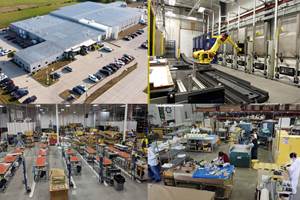PUR sandwich panels enable 3D composite parts
CAMX 2025: Ascorium Industries is highlighting CompoLite technologies for the production of lightweight, dimensionally stable automotive components and structures.
Share
Source | Ascorium
(Königswinter, Germany) is featuring CompoLite, a lightweight and dimensionally stable composite sandwich panel. At its most basic level, these sandwich panels comprise a polyurethane (PUR) foam space between two layers of glass or natural fiber mats that are sprayed with rigid PUR foam, penetrating the sandwich, fully curing and thus stabilizing the CompoLite component (read more about the technology here).
CompoLite offers high thermal and acoustic insulation properties and energy absorption capacity, as well as optimal stiffness and strength. Standard dimensions are 4' × 8' (longer boards are optional) or 3D molded. Thicknesses include ¼", 1/2", 5/8", ¾" 1", 1 ¼" and 1 ½"; other thicknesses are optional.
CompoLite substrates may be finished with all surfaces commonly used in the marine, RV, furniture and automotive interior trim sectors, and any decorative material is suitable.
CompoLite Black is Ascorium’s base version available in three variants: Optimized Performane (OP), High Performance (HP) and Extreme Performance (XP).
CompoLite PolyBak is available in the same variants as CompoLite Black. Polybak, is a resin-impregnated “paper” that is naturally bonded to both sides of the CompoLite during the manufacturing process. The PolyBak surface enables direct postprocesses such as lamination or painting.
CompoLite 3D uses the same technology as the flat boards but are molded into a 3D shape. During the molding process, Ascorium has the option of naturally bonding a UV-stable, highly durable and aesthetical PUR surface.
Related Content
-
Plant tour: Collins Aerospace, Riverside, Calif., U.S. and Almere, Netherlands
Composite Tier 1’s long history, acquisition of stamped parts pioneer Dutch Thermoplastic Components, advances roadmap for growth in thermoplastic composite parts.
-
MFFD longitudinal seams welded, world's largest CFRTP fuselage successfully completed
Fraunhofer IFAM and partners have completed left and right welds connecting the upper and lower fuselage halves and sent the 8×4-meter full-scale section to ZAL for integration with a cabin crown module and testing.
-
Thermoplastic composites: Cracking the horizontal body panel nut
Versatile sandwich panel technology solves decades-long exterior automotive challenge.
Related Content
Plant tour: Collins Aerospace, Riverside, Calif., U.S. and Almere, Netherlands
Composite Tier 1’s long history, acquisition of stamped parts pioneer Dutch Thermoplastic Components, advances roadmap for growth in thermoplastic composite parts.
Read MoreMFFD longitudinal seams welded, world's largest CFRTP fuselage successfully completed
Fraunhofer IFAM and partners have completed left and right welds connecting the upper and lower fuselage halves and sent the 8×4-meter full-scale section to ZAL for integration with a cabin crown module and testing.
Read MoreThermoplastic composites: Cracking the horizontal body panel nut
Versatile sandwich panel technology solves decades-long exterior automotive challenge.
Read MorePlant tour: Sekisui Aerospace, Orange City, Iowa, Renton and Sumner, Wash., U.S.
Veteran composites sites use kaizen and innovation culture to expand thermoplastic serial production, 4.0 digitization and new technology for diversified new markets.
Read MoreRead Next
Next-gen fan blades: Hybrid twin RTM, printed sensors, laser shock disassembly
MORPHO project demonstrates blade with 20% faster RTM cure cycle, uses AI-based monitoring for improved maintenance/life cycle management and proves laser shock disassembly for recycling.
Read MoreCutting 100 pounds, certification time for the X-59 nose cone
Swift Engineering used HyperX software to remove 100 pounds from 38-foot graphite/epoxy cored nose cone for X-59 supersonic aircraft.
Read MoreCeramic matrix composites: Faster, cheaper, higher temperature
New players proliferate, increasing CMC materials and manufacturing capacity, novel processes and automation to meet demand for higher part volumes and performance.
Read More









